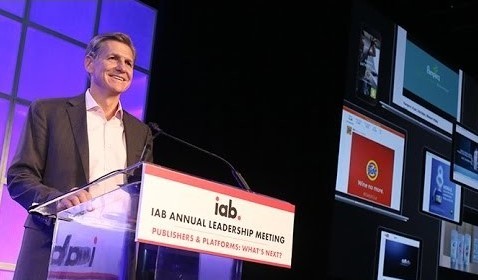
Photo Credit: IAB
A collective responsibility: heeding the advice on digital ad transparency
Marc Pritchard, Chief Brand Officer at P&G, has really shaken the industry with a reality check. His speech at the IAB Annual Leadership Meeting in Florida suggests that we’ve had enough of the complex systems around media transparency; it’s time to tackle the issue head-on and adopt a common standard to clean up the media supply chain.
He went on to identify four fairly simple action points, urging open adoption by all. We take a look at his recommendations.
-
Adopt one viewability standard
The excessive quantity of viewability standards used by companies has created a vicious cycle of complexity, sapping the money and hours of resources spent verifying the validity of each. Hence, Pritchard asserts that the way forward is to adopt one standard; a concerted effort of change that should be heralded by all. He states that this is already being exercised by P&G, who will only be working with those who comply with the MRC viewability standard.
At MainAd we recognised the importance of viewability early on from our partnership with Alenty, the first company to successfully measure viewability (later acquired by AppNexus in 2014). Today, we acknowledge the existence of different hierarchies in viewability and continue to welcome the standards set by the MRC & IAB. We agree with Pritchard, adopting one standard is a step in the right direction of accepting a shared level of error, and thus providing the basis to improve the current problem of comparing and scoring traffic providers.
-
Implement accredited third party measurement verification
Pritchard highlights that the lack of objective validated measurement is to the detriment of the integrity of how we should operate in the industry. The excuses given and readily accepted are complicit in spreading the biased practice. We should demand to be more impartial in the data we acquire and share, not just for our dollars spent but for the betterment of customers. Compared to TV, we fall short in taking action. There is a need for tech investment, as well as issues to be addressed around data privacy, something P&G have been trying to pursue for nearly a year.
As a retargeting provider with in-house platforms, our standard practice at MainAd, unlike others, is to cross-reference our primary sourced data with third party acquired data. We’re able to safeguard results for our clients that are transparent and credible, against their ad spend.
-
Get transparent agency contracts
Unfortunately, kickbacks are still common practice amongst many international agencies, compromising opportunities and margins. Pritchard suggests that bad business practice comes from lacking knowledge of the monetary value of partnerships, alongside applying vigilance on contract clauses. A change of attitude towards complacency and awareness is crucial to the clean-up of these ‘murky’ practices.
MainAd’s services work on a CPA model meaning our clients only get what they pay for. There are no hidden fees, no set up or maintenance cost and most of all, zero risk. Consequently, our clear approach has enabled us to maintain strong relationships with many well-established international brands, across our decade experience in multiple industries like fashion, retail and travel.
-
Prevent ad fraud
Ad Fraud is still a major concern in the online industry despite the IAB’s efforts as early as 2012. Pritchard emphasises the importance, to buyers, sellers and intermediaries within the digital advertising supply chain, of being TAG certified against fraud to prevent criminal activity.
As a media buyer from all major DSPs, we have seen increasing efforts made, by MainAd partners, to provide greater transparency and control over ads which we fully support. Efforts like those undertaken by AppNexus in 2015, through their Inventory Quality (IQ) initiative, attempted to purge fraudulent or invalid inventory from their platform. Inevitably, the cost of CPM and traffic volumes were adversely affected but confidence resumed in knowing the eventuality meant better quality traffic.
Vote with your money
As he closed his speech, Pritchard mentioned one last action point; we should choose where we spend our money. Agencies, suppliers, publishers and ad tech companies are expected to comply with these standard, otherwise if they are not prepared to, they are at risk of losing the business opportunity.
Time is of the essence and Pritchard urged action now to avoid wasting time and money, when we could be “investing in raising the bar of the creative craft”, as he put it.
Summary
It was no easy feat to address the digital community in the way Pritchard did. As he stated in the opening of his speech, “driving media transparency should not be optional, it’s a responsibility”. We are all part of the problem as well as the solution and would do well to productively adhere to the advice and make the change needed.
Pritchard acknowledged that these problems and solutions are not new. However, a matter of ‘collective will’ can be the difference in how we move towards cleaning up the ‘craft vs. crap’ issues that hamper the growth of this 70-billion-dollar industry.
We value his points and already commit to clear and transparent processes. We believe it is crucial to have a clean streamline of common standards within the digital ad space to form a better unity in the industry.
Watch his full speech here: https://www.youtube.com/watch?v=NEUCOsphoI0